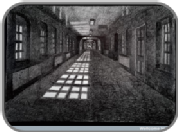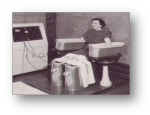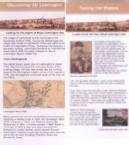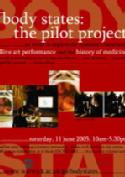Public Engagement & Impact
My research is concerned with the history of mental illness and asylums, women's experiences of mental disorder, the relationship between childbirth and mental breakdown, and infanticide, particularly in the nineteenth century. Another major project, in collaboration with Dr Catherine Cox (University College Dublin), focused on the experiences of Irish migrants to Britain and their vulnerability to mental disorder and confinement. This body of work has resulted in several public engagement and impact activities, notably with theatre companies:
Prisoners, Medical Care and Entitlement to Health in England and Ireland, 1850-2000 (2017-20)
Work on the project has resulted in numerous public outreach activities, including the production of a new theatre piece and the third and final production of our Asylum Trilogy 'Disorder Contained', a theatre of testimony production, a week at the Tate Modern (Tate Exchange), an exhibition, a learning resource, and several residencies in prisons working with theatre companies specialising in work in criminal justice settings.
Electric Dreams (2015)
I advised the London-based theatre company Dumbshow on their production 'Electric Dreams', inspired by Naomi Klein's book The Shock Doctrine and funded by a Wellcome Trust People Award. The plays explored the experimental approaches of Dr Ewen Cameron in seeking to erase his patients' memories through ECT and drugs such as LSD in 1950s Canada, and the devastating impact on his patients. The play was performed at Camden People's Theatre in May 2015 and at the Edinburgh Fringe.
'Asylum Trilogy' (2013, 2014)
I worked with the Coventry-based theatre group Talking Birds to develop an 'Asylum Trilogy, a series of three specially commissioned theatre productions on the history of insanity and its confinement'. The first production, the 'Trade in Lunacy', was performed in June 2013 in Coventry's Shop Front Theatre, a chamber piece exploring the cure, containment and corruption associated with the eighteenth-century private asylum trade.
Further information on the performance, a series of short articles on the asylum trade, and videos of the performance and panel discussion are available on the 'Trade in Lunacy' webpage.
In summer 2014 together with Catherine Cox, we produced the second piece of work, 'A Malady of Migration', which was based on our original research on Irish migration to Lancashire in the post-famine years, drawing on patient case notes and other archival material. The second production was peformed in Coventry and Dublin.
'Polevault: The Dark History of Canals' (2012)
I also worked with Talking Birds on their 'Decathlon 2012' project inspired by the London Olympic Games. 'Polevault' explores some of the dark secrets held by canals, stories of drowning, mental illness and infanticide.
'Madness, Migration and the Irish in Lancashire, c.1850-1921' (2010-13)
This Wellcome Trust funded project examines whether particular stereotypes concerning the Irish influenced their admission to asylums and experiences of care, and how concerns about the very visible rise in their numbers were linked to changing debates about insanity at a time of massive growth in asylum numbers overall. The project's Research Fellow, Dr Sarah York, produced a videocast presenting our initial findings.
The videocast is available on YouTube.
'The Last Women' (2008)
A collaboration between the Centre for the History of Medicine (Dr Norwood Andrews) and the Coventry-based Triangle Theatre Company, 'The Last Women' was inspired by the histories of Mary Ball, hanged in Coventry in 1849 and Ruth Ellis, the last woman to be hanged in Britain in 1955. I acted as a specialist-participant and contributed material on puerperal insanity and motherhood.
Find out more from the project website.
Hysteria and Film (2008)
The seminar Hysteria and Film was held in conjunction with the School of Theatre, Performance and Cultural Policy Studies at Warwick University, and was funded by the Humanities Research Centre. The event featured two independent films dealing in different ways with issues of hysteria, mass hysteria, femininity, and performance: 'Madness of the Dance', directed by Carol Morley and 'Programme', directed by Richard Squires. I hosted the event and led a post-screening audience discussion.
'Healing Cultures, Medicine and the Therapeutic Uses of Water in the English Midlands, 1840-1948'
(Professor Hilary Marland, Dr Jane Adams and Dr Michael Bevan)
Funded by two Wellcome Trust Project grants, this research project explored the use of water in English medicine between 1840 and 1948. It highlighted water's role as a continued mainstay of a rich and varied spectrum of therapeutic approaches. The project included a number of public outreach activities in collaboration with the Leamington Spa Musuem & Art Gallery, which is situated in the Royal Pump Rooms, Leamington Spa:
'Pulling the Plug?: An Oral History of Spa Practices and Experiences at the Royal Pump Rooms' (2007-08)
'Pulling the Plug?' explored, chiefly through interviews, the practices and experiences of water therapy in the second half of the twentieth century, as undertaken at the Royal Pump Rooms in Leamington Spa. The project involved approximately 40 interviews with patients, medical practitioners, physiotherapists and other health care workers who had treatment or worked at the Royal Pump Rooms.
Transcripts of the interviews are available on the project website.
'Taking the Waters' and 'Discovering Old Leamington': Walking Tours of Leamington Spa
'Healing Cultures' led to the development of two walking tours of Leamington Spa. 'Taking the Waters' highlighted water cure activities in the town and local healing wells. The trail explored the Old Town, taking in Robbins' Well, Reads' Baths and Smart's Marble Bath. 'Discovering Old Leamington' explored the development of Royal Leamington Spa in the nineteenth century and the town's importance as a spa resort.
'60%: Water and the Body' (2005)
I co-organised, with Dr Molly Rogers(Centre for the History of Medicine) and Alison Plumridge (Leamington Spa Art Gallery & Museum), an inter-disciplinary day-conference at the Assembly Rooms, Royal Pump Rooms. It involved historians of medicine and art and visual and performance artists who explored the theme of water and the body in art and medicine, and was attended by a diverse audience.
Visit the conference website.
Gifted Students Study Day (2004)
The study day was organised by the National Academy of Gifted and Talented Youth, with the participation of the Centre for the History of Medicine. Twenty students aged 12-16 visited the Royal Pump Rooms, Leamington Spa, to explore the health giving properties of water and the rise of the spa.
Find out more.
Another strand of my work relates to the history of childbirth and the provision of maternity care. This has stimulated public and media interest, including:
'Debating Reproduction: Hospital Birth' (November, 2012)
I was invited to contribute to a panel and public audience discussion on the hospitalisation of childbirth in the twentieth century.The debate was part of the Festival of Ideas held at the University of Cambridge, and focused on the causes of the transition of birth to the hospital. The panel and around 50 members of the audience debated whether the hospitalisation of childbirth has historically benefitted women, midwives or doctors, the rapid shift to hospital births in the 1960s and 1970s, and the historical and cultural roots of this process.
Details of the event are available at the Festival of Ideas website.
'Witness Seminar on Changing Childbirth Twenty Years on: Genesis, Implementation and Legacy' (17 October 2013)
I chaired an afternoon Witness Seminar held at the Royal College of Obstetrician and Gynaecologists, 17 October 2013 which debated the state of maternity services prior to the influential report Changing Childbirth in 1993, its genesis, implementation and short and long term impact. The panel included Baroness Julia Cumberledge, CBE DL, Sir Nicholas Winterton DL, and senior midwives, GPs and obstetricians involved in the production of the report. A large lively and well-inflormed audience joined in the discussions.
BBC Radio 4
'Childbed Fever and the Spreading of Infection', 23 January 2008: http://www.bbc.co.uk/radio4/womanshour/04/2008_04_wed.shtml
'Battle for Birth', 7 February 2007: http://www.bbc.co.uk/radio4/science/battleforbirth.shtml
'Depression and Childbirth in the Nineteenth Century', 21 July 2004: http://www.bbc.co.uk/radio4/womanshour/2004_29_wed_02.shtml
'Lying-in and the History of Childbirth', Woman's Hour, 8 December 1998 (no link available)
Television
'Royal Deaths and Diseases', Channel 4, broadcast 31 January 2003
Live Art Performance and the History of Medicine
'Body States: The Pilot Project' (2005)
A voyage through a man's gasto-intestinal tract and a chance to contemplate the human body as a doctor or surgeon might - these were just some of the opportunities presented to the audience of 'Body States', a collaboration between the Centre for the History of Medicine and the School of Theatre, Performance and Cultural Policy Studies, organised by Hilary Marland and Molly Rogers with Jim Davis and Nicolas Whybrow (Theatre Studies). The project brought together five live artists - Ansuman Biswas, Anna Dumitriu, Jo Gosling, Phillip Warnell, and Louise Wilson - to explore the common concerns of the disciplines of performance and medical history. After all five artists had presented their work, the audience was invited to put questions to them. The event attracted a diverse audience, including artists, historians and members of the general public.
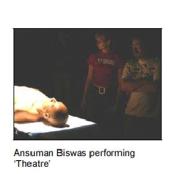
Further details about the event are available here.
The Body States project led on to a series of projects with live artist, Phillip Warnell, including a Leverhulme Trust funded project, The Anxious Object.

